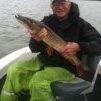-
Posts
1,137 -
Joined
-
Last visited
Reputation Activity
-
 Stuntflyer reacted to Chuck in 18th Century Longboat by Mike Y - Model Shipways - 1:48
Stuntflyer reacted to Chuck in 18th Century Longboat by Mike Y - Model Shipways - 1:48
Yes I know....that isnt your fault...Take a look at the plans, It may be hard to tell on the paper plans at the actual scale but the bottoms were flattened during laser cutting. There is a tight curve there and the tolerances in the ME laser cutting is not tight enough to keep the curve you noticed with the pinnace. Those sharper points were just cut away. It happens. They were able to do so on the pinnace I suspect only because of the larger scale. Even though a tight curve doesnt exist for the reasons mentioned, it should be there. When fairing the bulkheads it should probably be sanded into the frames as much as possible. To mimic the tight curve - transition of frames, use the shape shown on the plans body plan. Depending on the consistency of their laser cutting it may be more pronounced and absent in some kits more than others. But the kerf they get while laser cutting is just too large to keep this detail.
Here are some images of those last three frames as they SHOULD appear and the body plan from the plans enlarged.
-
 Stuntflyer got a reaction from Ryland Craze in 18th Century Longboat by Stuntflyer (Mike) - FINISHED - Model Shipways
Stuntflyer got a reaction from Ryland Craze in 18th Century Longboat by Stuntflyer (Mike) - FINISHED - Model Shipways
David - your idea sounds really good but I wanted to try something I used to do on the airplanes to strengthen glued wing joints. When doing aerobatics with 90 degree pullouts at 60 mph, 10-15g stresses on the airplane are common.
1. First step was to glue the mast together with epoxy glue.
2. Use 1/2oz or 3/4oz fiberglass cloth, I chose 3/4 oz, to strengthen joint. 0.0015 thick.
3. Attach the cloth to the mast by spraying the cloth with spray adhesive and wrapping the cloth around the mast just once.
4. Here is a photo of the wrapped and glued cloth. At this point the joint is stronger but still not strong enough.
5. Apply 4 to 5 thin CA applications lightly sanded between coats. After the first application the mast is super strong without any flex at the joint. The additional applications will fill the weave of the cloth.
6. Finished mast repair
-
 Stuntflyer reacted to Mike Y in 18th Century Longboat by Mike Y - Model Shipways - 1:48
Stuntflyer reacted to Mike Y in 18th Century Longboat by Mike Y - Model Shipways - 1:48
Completed main part of planking. Now the decorative top planks left, they would be a bit special and I will add them after a treenailing and final sanding of the hull.
The hull was just rough sanded, final smooth sanding would be done after treenailing. So please pardon that "hairy" look of the wood!
Currently experimenting with various treenail sizes. Probably will go forward with single treenail per plank, 0.8-0.9mm in diameter.
Half offtopic:
I was walking on one of my favourite islands in Stockholm - so called "Ship Island" (Skeppsholmen). There is a boat building club there:
They do teach how to build and maintain historical boats.. Some very fine examples are tarred and parked nearby:
One day, when the kids will grow up and I will have plenty of time, I will build such boat just for fun.. Very fine workmanship!
-
 Stuntflyer got a reaction from Aussie048 in 18th Century Longboat by Stuntflyer (Mike) - FINISHED - Model Shipways
Stuntflyer got a reaction from Aussie048 in 18th Century Longboat by Stuntflyer (Mike) - FINISHED - Model Shipways
David - your idea sounds really good but I wanted to try something I used to do on the airplanes to strengthen glued wing joints. When doing aerobatics with 90 degree pullouts at 60 mph, 10-15g stresses on the airplane are common.
1. First step was to glue the mast together with epoxy glue.
2. Use 1/2oz or 3/4oz fiberglass cloth, I chose 3/4 oz, to strengthen joint. 0.0015 thick.
3. Attach the cloth to the mast by spraying the cloth with spray adhesive and wrapping the cloth around the mast just once.
4. Here is a photo of the wrapped and glued cloth. At this point the joint is stronger but still not strong enough.
5. Apply 4 to 5 thin CA applications lightly sanded between coats. After the first application the mast is super strong without any flex at the joint. The additional applications will fill the weave of the cloth.
6. Finished mast repair
-
 Stuntflyer got a reaction from jburchfield1@wowway.com in 18th Century Longboat by Stuntflyer (Mike) - FINISHED - Model Shipways
Stuntflyer got a reaction from jburchfield1@wowway.com in 18th Century Longboat by Stuntflyer (Mike) - FINISHED - Model Shipways
David - your idea sounds really good but I wanted to try something I used to do on the airplanes to strengthen glued wing joints. When doing aerobatics with 90 degree pullouts at 60 mph, 10-15g stresses on the airplane are common.
1. First step was to glue the mast together with epoxy glue.
2. Use 1/2oz or 3/4oz fiberglass cloth, I chose 3/4 oz, to strengthen joint. 0.0015 thick.
3. Attach the cloth to the mast by spraying the cloth with spray adhesive and wrapping the cloth around the mast just once.
4. Here is a photo of the wrapped and glued cloth. At this point the joint is stronger but still not strong enough.
5. Apply 4 to 5 thin CA applications lightly sanded between coats. After the first application the mast is super strong without any flex at the joint. The additional applications will fill the weave of the cloth.
6. Finished mast repair
-
 Stuntflyer got a reaction from samueljr in 18th Century Longboat by Stuntflyer (Mike) - FINISHED - Model Shipways
Stuntflyer got a reaction from samueljr in 18th Century Longboat by Stuntflyer (Mike) - FINISHED - Model Shipways
David - your idea sounds really good but I wanted to try something I used to do on the airplanes to strengthen glued wing joints. When doing aerobatics with 90 degree pullouts at 60 mph, 10-15g stresses on the airplane are common.
1. First step was to glue the mast together with epoxy glue.
2. Use 1/2oz or 3/4oz fiberglass cloth, I chose 3/4 oz, to strengthen joint. 0.0015 thick.
3. Attach the cloth to the mast by spraying the cloth with spray adhesive and wrapping the cloth around the mast just once.
4. Here is a photo of the wrapped and glued cloth. At this point the joint is stronger but still not strong enough.
5. Apply 4 to 5 thin CA applications lightly sanded between coats. After the first application the mast is super strong without any flex at the joint. The additional applications will fill the weave of the cloth.
6. Finished mast repair
-
 Stuntflyer got a reaction from Mike Y in 18th Century Longboat by Stuntflyer (Mike) - FINISHED - Model Shipways
Stuntflyer got a reaction from Mike Y in 18th Century Longboat by Stuntflyer (Mike) - FINISHED - Model Shipways
David - your idea sounds really good but I wanted to try something I used to do on the airplanes to strengthen glued wing joints. When doing aerobatics with 90 degree pullouts at 60 mph, 10-15g stresses on the airplane are common.
1. First step was to glue the mast together with epoxy glue.
2. Use 1/2oz or 3/4oz fiberglass cloth, I chose 3/4 oz, to strengthen joint. 0.0015 thick.
3. Attach the cloth to the mast by spraying the cloth with spray adhesive and wrapping the cloth around the mast just once.
4. Here is a photo of the wrapped and glued cloth. At this point the joint is stronger but still not strong enough.
5. Apply 4 to 5 thin CA applications lightly sanded between coats. After the first application the mast is super strong without any flex at the joint. The additional applications will fill the weave of the cloth.
6. Finished mast repair
-
 Stuntflyer got a reaction from HIPEXEC in 18th Century Longboat by Stuntflyer (Mike) - FINISHED - Model Shipways
Stuntflyer got a reaction from HIPEXEC in 18th Century Longboat by Stuntflyer (Mike) - FINISHED - Model Shipways
I finished the oarlocks, the horse located in front of the transom and red paint work today.
Looks crude but it works. Made from scrap 3/32" aluminum stock to even out the oarlocks using a file.
The oarlocks were painted with the same wood tone color that I used on the belaying pins in order to lighten the color of the wire. I then did all the red painting as necessary including the oarlocks. All of the red was then sprayed with the Testors clear dull coat. I sprayed the clear into an airbrush container and used the airbrush to spray. This gave me finer control over the area being sprayed. Even though you can't see it in the photo the red has no shine at all and looks very evenly toned now that it has been sprayed with the Testors Dullcoat.
-
 Stuntflyer reacted to Mike Y in 18th Century Longboat by Mike Y - Model Shipways - 1:48
Stuntflyer reacted to Mike Y in 18th Century Longboat by Mike Y - Model Shipways - 1:48
Got a new toy today! Would be used for the next project
Frankly, I thought this micro band saw is smaller. It is a 8kg thing that occupies half of the table! But the quality is really good, so far I'm pretty happy. Let's see how it will manage a sawdust generation on a large scale.
-
 Stuntflyer reacted to dgbot in 18th Century Longboat by Stuntflyer (Mike) - FINISHED - Model Shipways
Stuntflyer reacted to dgbot in 18th Century Longboat by Stuntflyer (Mike) - FINISHED - Model Shipways
One way of repairing is to add another piece. Cut of 1/4 of an inch off of each part making sure the cut is square. Using a #78 or 79 drill make a hole in the center of each. Make a dowel 1l2 an inch long just a litte wider than you need and drill that as well connect the parts together using a piece of wood that will fit the holes. Once the glue has set feather and paint. This is what I have done in the past. Your accident has happened to many of over the years. By having large hands some more than most.
David B
-
 Stuntflyer got a reaction from jburchfield1@wowway.com in 18th Century Longboat by Stuntflyer (Mike) - FINISHED - Model Shipways
Stuntflyer got a reaction from jburchfield1@wowway.com in 18th Century Longboat by Stuntflyer (Mike) - FINISHED - Model Shipways
This is what happens when your not careful.
-
 Stuntflyer got a reaction from WackoWolf in 18th Century Longboat by Stuntflyer (Mike) - FINISHED - Model Shipways
Stuntflyer got a reaction from WackoWolf in 18th Century Longboat by Stuntflyer (Mike) - FINISHED - Model Shipways
Just did my first ever seizing even though it took 5 attempts to get it halfway right.
-
 Stuntflyer got a reaction from mtaylor in 18th Century Longboat by Stuntflyer (Mike) - FINISHED - Model Shipways
Stuntflyer got a reaction from mtaylor in 18th Century Longboat by Stuntflyer (Mike) - FINISHED - Model Shipways
Just did my first ever seizing even though it took 5 attempts to get it halfway right.
-
 Stuntflyer got a reaction from Ryland Craze in 18th Century Longboat by Stuntflyer (Mike) - FINISHED - Model Shipways
Stuntflyer got a reaction from Ryland Craze in 18th Century Longboat by Stuntflyer (Mike) - FINISHED - Model Shipways
Just did my first ever seizing even though it took 5 attempts to get it halfway right.
-
 Stuntflyer got a reaction from Chuck in 18th Century Longboat by Stuntflyer (Mike) - FINISHED - Model Shipways
Stuntflyer got a reaction from Chuck in 18th Century Longboat by Stuntflyer (Mike) - FINISHED - Model Shipways
Some photos of the mast. The sheaves are there but not seen from this view.
-
 Stuntflyer got a reaction from Chuck in 18th Century Longboat by Stuntflyer (Mike) - FINISHED - Model Shipways
Stuntflyer got a reaction from Chuck in 18th Century Longboat by Stuntflyer (Mike) - FINISHED - Model Shipways
Just did my first ever seizing even though it took 5 attempts to get it halfway right.
-
 Stuntflyer got a reaction from jburchfield1@wowway.com in 18th Century Longboat by Stuntflyer (Mike) - FINISHED - Model Shipways
Stuntflyer got a reaction from jburchfield1@wowway.com in 18th Century Longboat by Stuntflyer (Mike) - FINISHED - Model Shipways
Just did my first ever seizing even though it took 5 attempts to get it halfway right.
-
 Stuntflyer got a reaction from samueljr in 18th Century Longboat by Stuntflyer (Mike) - FINISHED - Model Shipways
Stuntflyer got a reaction from samueljr in 18th Century Longboat by Stuntflyer (Mike) - FINISHED - Model Shipways
Some photos of the mast. The sheaves are there but not seen from this view.
-
 Stuntflyer got a reaction from Beef Wellington in 18th Century Longboat by Stuntflyer (Mike) - FINISHED - Model Shipways
Stuntflyer got a reaction from Beef Wellington in 18th Century Longboat by Stuntflyer (Mike) - FINISHED - Model Shipways
Finished the bowsprit today. I painted all the parts off the model to keep things looking as clean as possible.
I glued the "bowsprit step" in place as per the instructions. After sliding the end of the bowsprit into the step I slid the smaller brass band up against the stem. Once I was sure that there was no play fore and aft I spot glued the small brass band to the bowsprit. I then removed the bowsprit from the "bowsprit step" by pulling the bowsprit gently forward. Once removed, I applied more glue to the brass band and painted the bowsprit behind the brass band black. I then glued everything permanently into place.
-
 Stuntflyer got a reaction from samueljr in 18th Century Longboat by Stuntflyer (Mike) - FINISHED - Model Shipways
Stuntflyer got a reaction from samueljr in 18th Century Longboat by Stuntflyer (Mike) - FINISHED - Model Shipways
Just did my first ever seizing even though it took 5 attempts to get it halfway right.
-
 Stuntflyer reacted to Mike Y in 18th Century Longboat by Mike Y - Model Shipways - 1:48
Stuntflyer reacted to Mike Y in 18th Century Longboat by Mike Y - Model Shipways - 1:48
Mike, you are right, probably I'm just overcomplicating it Anyway, I have a wale planks coming soon, and I will do them in a bit weird way instead of gluing the friezes!
-
 Stuntflyer reacted to jburchfield1@wowway.com in 18th Century LongBoat by jburchfield1 - Model Shipways - 1/4" scale - SMALL - 1st ever build
Stuntflyer reacted to jburchfield1@wowway.com in 18th Century LongBoat by jburchfield1 - Model Shipways - 1/4" scale - SMALL - 1st ever build
Floyd - Yeah, I tried the acetone, didn't clean it enough. My process was - draw the brass thru some 400 sand paper a couple times on the flat surface, then soak in acetone for 10 minutes, rinse, soak in vinegar for 10 minutes, rinse, soak in Novacan Black for about 10 min, rinse, pat dry.
I figured the acetone would remove finger oils left after sanding/handling.
However, I used a 10 to 1 ratio for the Novacan Black. Maybe not strong enough because I noticed that it rubbed off in a couple small spots.
Actually, just read the instructions (gotta learn to do that first) and it says to use it straight from the bottle - so that's probably the problem.
-
 Stuntflyer got a reaction from Mike Y in 18th Century Longboat by Mike Y - Model Shipways - 1:48
Stuntflyer got a reaction from Mike Y in 18th Century Longboat by Mike Y - Model Shipways - 1:48
Mike,
Page 4 of Chucks manual explains how to bend planks 90 degrees so they fit against the false keel. There are 3 after the garboard plank that need this type of bending. He also explains about beveling the edges where necessary to get a tight fit between the planks. I don't know if your using boxwood makes this impossible to do. With basswood it's quite easy. If it would be helpful for you to see photos of the process, I would be happy to post a few. Mike
-
 Stuntflyer reacted to fnkershner in 18th Century LongBoat by jburchfield1 - Model Shipways - 1/4" scale - SMALL - 1st ever build
Stuntflyer reacted to fnkershner in 18th Century LongBoat by jburchfield1 - Model Shipways - 1/4" scale - SMALL - 1st ever build
Pops, Did you try Acetone? I prefer the Acetone to sanding. But you are correct you need to treat the metal before you blacken. I soak in Acetone then rinse. After everything is completely dry I blacken. I use a 2:1 mixture of the Blacken It. I am also careful to rinse this so that the chemical reaction stops. And then get it completely dry so that there is no rust.
-
 Stuntflyer reacted to fnkershner in 18th century Longboat by fnkershner (Floyd Kershner) - Model Shipways - 1:48
Stuntflyer reacted to fnkershner in 18th century Longboat by fnkershner (Floyd Kershner) - Model Shipways - 1:48
So let me offer an update as we go into the weekend.
The first picture shows the false deck and scrap for grabbing (thank you Mike)
The last Picture shows it in the vice. Let the Fairing Begin!










